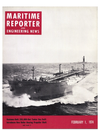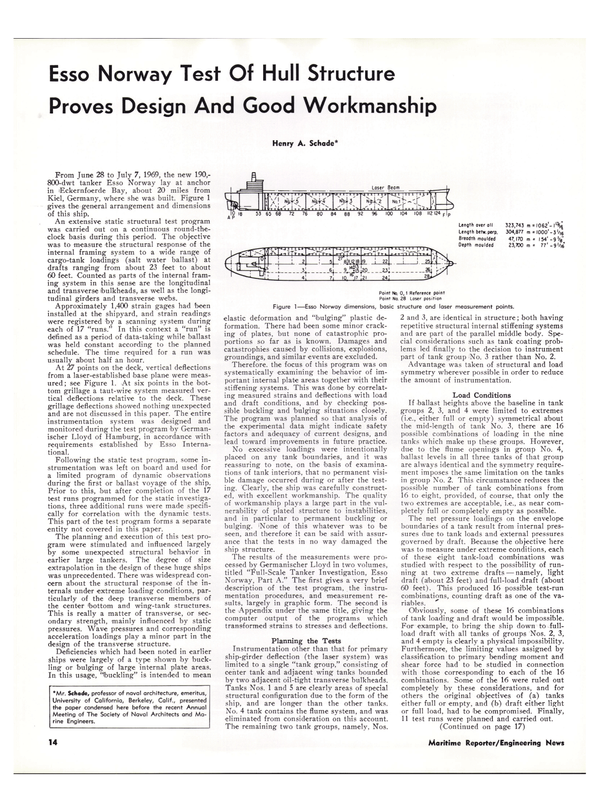
Aluminum Tanks And LNG Ship Steel Hulls To Be Joined By Using Du Pont Detacouple Explosion Bonded Welding Transition Joints
The first three liquid natural gas tankers to be 'built in this country using the spherical design will incorporate the Du Pont Company's "Detacouple^ explosion bonded welding transition joints to attach the aluminum cryogenic cargo tanks to the ship's steel structure.
The "Detacouple" t r a n s i t i on joints were selected because they offer greater economy in installation than a mechanical joint.
The tankers are Ibeing built by the General Dynamics Corporation at its Quincy, Mass., shipyard. The cryogenic cargo tanks are being supplied by iPittsburgh-Des Moines Steel Company's subsidiary, World Southern Corporation, near Charleston, S.C. The first of the three tankers is scheduled for launch in mid-1975.
Each of the tankers will carry five spherical aluminum cryogenic tanks 120 feet in diameter. The tanks will be supported by 18-footlong aluminum skirts attached to the spheres at their equators and to the ship's structure at the top of matching steel skirts.
The joining of the aluminum and steel skirts will be accomplished using the "Detacouple" transition joints butted one against the other around the full 377-foot circum- ference of the skirts. The "Detacouple" transition joints will consist of -inch-thick 5083 aluminum explosion bonded to %-inch-thick normalized and impact tested steel plate with an interiayer of ^-inchthick 1100 aluminum. The explosion bonding process forms a metallurgical bond between the metals, which cannot be fusion welded directly to one another.
When the tankers are in use, the transition joints will bear both the weight of the filled cargo tanks and the dynamic forces created by the ship's motion at sea.
The aluminum skirt supporting each tank will be welded to the aluminum portion of the transition joints during fabrication of the tank structure. The steel-to-steel welds joining the steel portion of the transition joints to the steel skirt of the tankers' structure will be made upon installation of the cryogenic cargo tanks at the shipyard.
According to a General Dynamics spokesman, the "Detacouple" transition joints were selected for the tankers because it is easier and less costly to weld the transition joints than to flange the aluminum and steel skirts and join them with bolts or other mechanical devices.
Read Aluminum Tanks And LNG Ship Steel Hulls To Be Joined By Using Du Pont Detacouple Explosion Bonded Welding Transition Joints in Pdf, Flash or Html5 edition of February 1974 Maritime Reporter
Other stories from February 1974 issue
Content
- Shipyard Marketing Conference Planned page: 4
- Cordon International To Supply Equipment For Three LNG Ships page: 6
- Sixth VLCC Delivered By Kockums To Salen Features Roller Bearing Design For Shaft page: 7
- Admiral Payne To Succeed Admiral Brockett At Webb page: 7
- NASSCO Launches Largest Vessel Ever Built On West Coast page: 7
- Walter Thorsen, Inc. Named Exclusive Rep For Eleusis Shipyards page: 8
- Ogden Marine, Inc. Buys Two Tankers page: 10
- Oceans International Announces Merger And Expansion Plans page: 10
- Aluminum Tanks And LNG Ship Steel Hulls To Be Joined By Using Du Pont Detacouple Explosion Bonded Welding Transition Joints page: 11
- McAllister Orders Three 4,290-Hp Tugs page: 11
- Delta SS Awards Contract To Equitable For 50 LASH Barges page: 12
- Bethlehem Begins Construction On 265,000-Dwt Tanker —Largest Vessel Built In The United States page: 12
- Arthur Levy Boat Service Announces New Appointments For Thomas And LeBlanc page: 12
- Greek Committee Established By Det norske Veritas page: 13
- Esso Norway Test Of Hull Structure Proves Design And Good Workmanship page: 14
- Todd President Sees U.S. Shipbuilders Improving Competitive Position page: 14
- Society Of Marine Port Engineers N.Y. Discuss Care Of Turbine And Hydraulic Oil Systems page: 14
- Harwich Tonnage, Inc. Formed In California page: 15
- K.W. Waldorf Named To New Zapata Post page: 15
- Bigger, Bigger . . . Bigger page: 18
- USMMA At Kings Point To Admit Women page: 19
- Storm Awards Contract To Bethlehem Beaumont Shipyard For Offshore Drilling Rig page: 20
- NASSCO Expanding Facilities To Build 150,000-Ton Tankers page: 20
- NASSCO Delivers S/S Coronado— First Of Three For Margate Shipping page: 21
- SNAME N.Y. Metropolitan Section Hears Technical Paper On 'New Approach To The Ship Hull Characteristics Problem' page: 21
- ASNE Annual Meeting Set For May 2-3 In Washington, D.C. page: 21
- Experimental LNG Carrier Will Evaluate Two Tank Systems Under Operating Conditions page: 24
- International Ship Suppliers To Meet In Washington, D.C. September 22-26 page: 24
- Thomas B. Crowley Elected President At Western Shipbuilding Ass'n Annual Meeting page: 24
- Whitehouse To Head ABStech Regional Office In Houston page: 25
- Colt Industries Names Nidenberg page: 25
- FMD Appoints Sanchez To Direct Field Operations page: 25
- Alco Engines Names Comeng Holdings Ltd. Australian Licensee page: 25
- Magnavox Announces New Integrated Navigation System page: 28
- Friede & Goldman Inc. Design Zapata Rigs Building At Avondale page: 28
- Sea Trials And Launching Ceremonies Held For AMOCO Tankers At Astilleros Espanoles page: 28
- Halter Delivers New York Pilot Boat page: 29
- Ametco Shipping Elects J.E. Hundt President page: 29
- World Dredging Ass'n New Midwest Chapter To Meet February 28 page: 29
- Wiley And Clyde Iron Now Division Of AMCA Int'l —AMCA Sales $100 Million page: 30
- Kaiser To Build LNG Tanks For Oceangoing Ships On Pinto Island In Mobile Bay page: 30
- Eleusis Shipyards Launches Largest Vessel Built In Greece page: 31
- Paclines To Carry Cargo California To Hawaii Using Tug And Superbarge page: 31
- L. Arthur Strenkert Named Sales Manager Smit Nymegen Corp. page: 31
- Magnavox Announces Offshore Drill Rig Positioning System page: 31
- Paul J. Evanson Appointed Controller Moore And McCormack page: 32
- Paper On Water jet Propulsion Discussed During SNAME Philadelphia Section Meeting page: 32
- Mainland China Places Order Worth $2 Million For Rucker Petroleum Drilling Equipment page: 33
- Pittsburgh-Des Moines Orders Large Quantity Of Aluminum For LNG Ship And Land Use page: 33
- Worthington Service Corp. Names Budrick And lennings page: 33
- Zapata Corporation Reports Record Results page: 33
- Drew Chemical Names Rogers Managing Director New So. Africa Subsidiary page: 33
- Luckenbach To Build New Tampa Terminal page: 33
- SNAME Players Perform At Pacific Northwest Section's 27th Annual Fall Meeting page: 33
- Japanese Firm Buys Lawson Products Corp. —John Gaydos Named page: 34
- David O'Neil To Head New Firm Of Marine Propulsion Consultants page: 34
- Liberian Services —Consulting Firm Elects Wiswall Pres. page: 35
- Diamond M Orders Two Jackup Rigs And A Semisubmersible page: 35
- New Marine Systems Brochure From Waukesha Motor page: 36
- Management Changes At Dearborn-Storm page: 36
- Tanker Management Firm Promotes Nichols page: 36
- DOD Management Of Energy Resources Highlights Naval Engineers Meeting page: 37
- Raytheon Company Submarine Signal Div. Appoints R.G. Popovici page: 38
- Berwind Lines Names Bericochea Exec. VP page: 38
- Selective Calling System Saves Time For Oceangoing Tankers And River Vessels page: 40
- Storehouse Of Information Readily Available From ABS Using Computerized Retrieval page: 42


